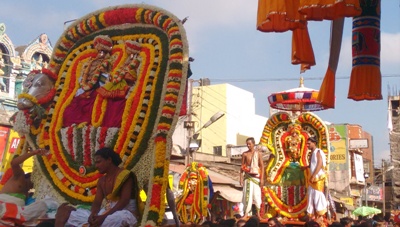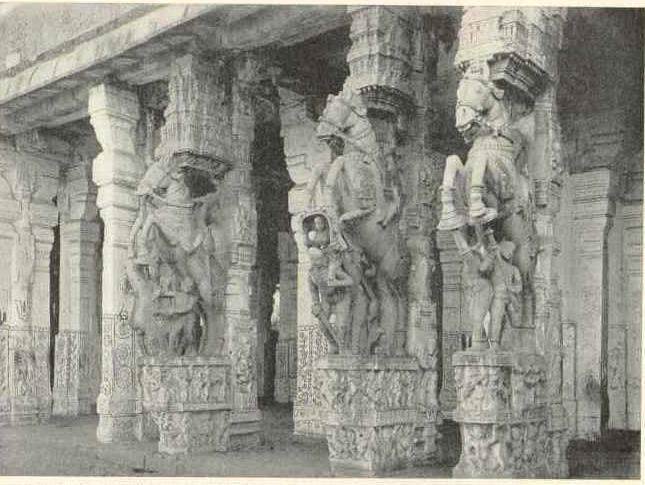|
Sodasa Linga Mandapas, Kumbakonam
Sodasa Linga Mandapas are Hindu temples dedicated to the deity Shiva, the mandapas or temples found around the Mahamaham tank, Kumbakonam, Mahamaham tank in Kumbakonam in Thanjavur district, Tamil Nadu, India. Sodasa Sodasa refers to sixteen. 16 mandapas These 16 mandapas are devoted to Brammatheerthesvarar, Mukundesvarar, Dhanesvarar, Virushabesvarar, Baanesvarar, Konesvarar, Bhakthikesvarar, Bhairavesvarar, Agasthisvarar, Vyasakesvarar, Umabakevarar, Nirutheesvarar, Brammesvarar, Gangathesvarar, Mukthatheerthesvarar, and Shethrabalesvarar. They were represented by the ''lingam''. Govinda Dikshitar, the chieftain of Nayaks of Tanjore#Ragunatha Nayak, Ragunatha Nayak of Thanjavur, constructed the sixteen mandapams and stone steps around this tank.#V., V. 1995, p.120 Of the mandapas, in the biggest one, the sculpture of offering of gold by Ragunatha Nayak is found. In other mandapas sculptures pertaining to the respective grants are found. Directions Around the Mahamaham t ... [...More Info...] [...Related Items...] OR: [Wikipedia] [Google] [Baidu] |
Govinda Dikshitar
Govinda Dikshita (Dikshitar) was the minister of three successive Nayaks of Thanjavur, who ruled the region of Thanjavur in South India between the 16th and 17th centuries CE. About the scholar Govinda Dikshita was a scholar, philosopher, statesman and musicologist. He was a Kannadiga (native Kannada language speaker) belonging to the Hoysala Karnataka Brahmin community, although he served as a minister in the region of Thanjavur under Achuthappa Nayak and Raghunatha Nayak. He lived in a palatial house in Patteeswaram, the remnants of which are believed to exist. This versatile genius and erudite scholar composed Arivamsa Saracharitram and Sangitha Sudhanidhi(a treatise on music). He is credited with the construction and repair of the Amman shrine of Thenupuriswarar Temple at Patteeswaram. The sculpture of Dikshita and his wife, holding their hands in adoration, are found in the ''mandap'' in front of the Amman shrine. Legend associates him with Tirunageswaram, a village ... [...More Info...] [...Related Items...] OR: [Wikipedia] [Google] [Baidu] |
2016 Mahamaham
2016 Mahamaham (2016 மகாமகம்) :ta:2016 மகாமகம் is a recurring festival most recently celebrated at Kumbakonam in Thanjavur district of Tamil Nadu, India from 13 February 2016 to 22 February 2016. Mahamaham, also known as ''Mahamagham'' or ''Mamangam'', is a Hindu festival celebrated every 12 years in the Mahamaham tank in Kumbakonam. Background Anticipating a deluge that would destroy the world, the creator Brahma sought the help of the lord Shiva, who created a pot containing nectar and the seeds of creation. Brahma decorated the pot with coconut, darbha, mango leaves, sacred thread, vastram and vilvam and performed worshipful puja, placing the pot atop the Meru Hill. When the deluge struck, the pot came to rest in Kumbakonam. Shiva, as a hunter, appeared and opened the pot, and nectar dispersed from it in different directions, emerging as sacred theertham water in the holy Potramarai tank (Sarangapani temple) and Mahamaham tank. Bath in holy ta ... [...More Info...] [...Related Items...] OR: [Wikipedia] [Google] [Baidu] |
Kasi Viswanathar Temple, Kumbakonam
Kasi Viswanathar Temple, Kumbakonam is a Hindu temple dedicated to Lord Shiva, located in Kumbakonam, Tamil Nadu, India. Here, Lord Shiva is worshipped as Kasi Viswanathar, and His consort Parvati is depicted as Visalakshi. The presiding deity is revered in the 7th-century Tamil Saiva canonical work, the ''Tevaram'', written by Tamil saint poets known as the nayanars and classified as ''Paadal Petra Sthalam''. The temple complex covers two acres and is located close to the Mahamaham tank. It houses two gateway towers known as ''gopurams''. The tallest is the western tower, with seven stories and a height of . The temple has numerous shrines, with those of Kasi Viswanathar, Visalakshi and Navakanniyar being the most prominent. The temple has six daily rituals at various times from 6:00 a.m. to 9 p.m., and twelve yearly festivals on its calendar. The ''Masi Magam'' festival is celebrated during the day of the Magam (February - March) is the most prominent festival. The p ... [...More Info...] [...Related Items...] OR: [Wikipedia] [Google] [Baidu] |
Mamankam Festival
Māmānkam or Māmāngam was a ''duodecennial'' medieval fair held on the bank, and on the dry river-bed, of Pērār (River Nil̥a, River Ponnani, or Bhārathappuzha) at Tirunāvāya, southern India. The temple associated with the festival was Nava Mukunda Temple in Tirunavaya. It seems to have begun as a temple festival, analogous to the Kumbha Melas at Ujjaini, Prayaga, Haridwar and Kumbakonam.William Logan, M. C. S., ''Malabar''. Vol I. Government Press Madras 1951 Tirunāvāya, is known for its ancient Hindu temples. The festival was most flamboyantly celebrated under the auspices and at the expenses of the Hindu chiefs of Kōzhikōde (Calicut), the Samutiris (the Zamorins). The fair was not only a religious festival for the Samutiris, but also an occasion for the display of all their pomp and power as the most powerful chiefs of Kerala. During the Mamankam it was believed that the goddess Ganga descended into the Perar and by her miraculous advent made the river as ho ... [...More Info...] [...Related Items...] OR: [Wikipedia] [Google] [Baidu] |
Kumbhabhishekham
''Kumbhabhishekam'', also known as ''Samprokshanam'' is a Hindu temple ritual that is believed to homogenize, synergize and unite the mystic powers of the deity. It is part of the consecration ceremony of Hindu temples. ''Kumbha'' means the Head and denotes the ''Shikhara'' or Crown of the Temple (usually in the ''gopuram'') and '' abhisekam'' or ''prokshanam'' is ritual bathing. Kumbhabhishekam is widely celebrated as a festival in South India. On the appointed day and at an auspicious time, the ''Kumbha'' is bathed with the charged and sanctified holy waters in the sacrificial pot and, by a mystic process, these pranic powers trickle down a silver wire and enter the deity installed inside the sanctum sanctorum of the temple. The deity, which was until then only a granite sculptured stone image, is believed to transform into a vibrant and vivid living representation of the deva with innate beatitude, grace and grandeur, conferring divine blessings on all devotees. Ashtabandhan ... [...More Info...] [...Related Items...] OR: [Wikipedia] [Google] [Baidu] |
Mandapam
Mandapam is a panchayat town in Ramanathapuram district in the Indian state of Tamil Nadu. The famed Pamban Railway bridge and Vehicular bridge lie to the East of this Panchayat Town. Mandapam is Tamil Nadu’s largest refugee camp for Sri Lankans in India. Geography Mandapam is located at . It has an average elevation of 9 metres (29 feet). Demographics India census A census is the procedure of systematically acquiring, recording and calculating information about the members of a given population. This term is used mostly in connection with national population and housing censuses; other common censuses incl ..., Mandapam had a population of 15,799. Males constitute 51% of the population and females 49%. Mandapam has an average literacy rate of 71%, higher than the national average of 59.5%: male literacy is 75%, and female literacy is 66%. In Mandapam, 13% of the population is under 6 years of age. The main occupation of the people living here is fishing. Part ... [...More Info...] [...Related Items...] OR: [Wikipedia] [Google] [Baidu] |
Thanjavur
Thanjavur (), also Tanjore, Pletcher 2010, p. 195 is a city in the Indian state of Tamil Nadu. Thanjavur is the 11th biggest city in Tamil Nadu. Thanjavur is an important center of South Indian religion, art, and architecture. Most of the Great Living Chola Temples, which are UNESCO World Heritage Monuments, are located in and around Thanjavur. The foremost among these, the Brihadeeswara Temple, is located in the centre of the city. Thanjavur is also home to Tanjore painting, a painting style unique to the region. Thanjavur is the headquarters of the Thanjavur District. The city is an important agricultural centre located in the Kaveri Delta and is known as the ''Rice bowl of Tamil Nadu''. Thanjavur is administered by a municipal corporation covering an area of and had a population of 290,720 in 2011. Roadways are the major means of transportation, while the city also has rail connectivity. The nearest airport is Tiruchirapalli International Airport, located away from th ... [...More Info...] [...Related Items...] OR: [Wikipedia] [Google] [Baidu] |
Nayaks Of Tanjore
The Thanjavur Nayak kingdom or Thanjavur Nayak dynasty were the rulers of Thanjavur in the 15th and 17th centuries. The Nayaks of the Balija social group, were originally appointed as provincial governors by the Vijayanagara Emperor in the 15th century, who divided the territory into Nayak kingdoms which were Madurai, Tanjore, Gingee and Kalahasthi. In the mid 15th century they became an independent kingdom, although they continued their alliance with the Vijayanagara Empire. The Thanjavur Nayaks were notable for their patronage of literature and the arts. A translation from '' Raghunathabhyudayam (p. 284)'', says this about Timma Nayak the father of Sevappa Nayak, the founder of the Tanjore Nayak in line: ''In the sathria caste born from the feet of Vishnu was born a king called Timma Nayak''.''Nayaks of Tanjore'', by V. Vriddhagirisan, p.26 The ''Mannaru'' (Vishnu) of the Mannargudi temple was their ''kula daivam'' (family deity). Origins of Nayak rule With the demise of the ... [...More Info...] [...Related Items...] OR: [Wikipedia] [Google] [Baidu] |
Lingam
A lingam ( sa, लिङ्ग , lit. "sign, symbol or mark"), sometimes referred to as linga or Shiva linga, is an abstract or aniconic representation of the Hindu god Shiva in Shaivism. It is typically the primary ''murti'' or devotional image in Hindu temples dedicated to Shiva, also found in smaller shrines, or as self-manifested natural objects. It is often represented within a disc-shaped platform, the ''yoni'' – its feminine counterpart, consisting of a flat element, horizontal compared to the vertical lingam, and designed to allow liquid offerings to drain away for collection. Together, they symbolize the merging of microcosmos and macrocosmos, the divine eternal process of creation and regeneration, and the union of the feminine and the masculine that recreates all of existence. The original meaning of ''lingam'' as "sign" is used in Shvetashvatara Upanishad, which says "Shiva, the Supreme Lord, has no liūga", liuga ( sa, लिऊग ) meaning he is transcen ... [...More Info...] [...Related Items...] OR: [Wikipedia] [Google] [Baidu] |
Hindu Temple
A Hindu temple, or ''mandir'' or ''koil'' in Indian languages, is a house, seat and body of divinity for Hindus. It is a structure designed to bring human beings and gods together through worship, sacrifice, and devotion.; Quote: "The Hindu temple is designed to bring about contact between man and the gods" (...) "The architecture of the Hindu temple symbolically represents this quest by setting out to dissolve the boundaries between man and the divine". The symbolism and structure of a Hindu temple are rooted in Vedic traditions, deploying circles and squares. It also represents recursion and the representation of the equivalence of the macrocosm and the microcosm by astronomical numbers, and by "specific alignments related to the geography of the place and the presumed linkages of the deity and the patron". A temple incorporates all elements of the Hindu cosmos — presenting the good, the evil and the human, as well as the elements of the Hindu sense of cyclic time and th ... [...More Info...] [...Related Items...] OR: [Wikipedia] [Google] [Baidu] |








